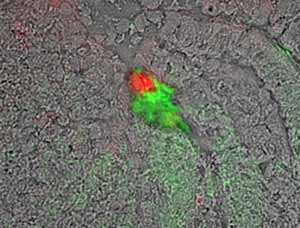The road to allergy

Immunofluorescent staining to show a protein body (red) within an M-cell (green).
A UK scientist has discovered the route and type of transport taken by peanut proteins through the gut to the immune system. This route favours an immune response, which helps explain why peanuts are one of the most allergenic foods.
Dr Claudio Nicoletti from the Institute of Food Research, said: “Food allergy is an immune system over-reaction to a food protein. The cause of this over-reaction has remained a mystery. Our aim was to identify the route that proteins from digested peanuts take to the lymphoid tissue of the gut where immune responses start”.
Firstly, using a digestion model, the research team found that digestion through the stomach and small intestine produces large amounts of soluble protein and intact protein bodies – large particle-like structures. Secondly, by labelling them with gold, Dr Nicoletti found that peanut proteins are delivered at high speed through the gut via M-cells.
M-cells are effective at rapidly delivering foreign bodies, including proteins, to defence cells. Protein bodies hitching a ride with M-cells are therefore likely to trigger defence cells into action. “Peanut proteins are delivered quickly, in large amounts and in highly immunogenic form to immune cells”, said Dr Nicoletti. “This may be important in explaining strong allergic reactions to peanuts”.
Peanuts frequently cause severe reactions, including potentially lethal anaphylaxis. Peanut allergy can be so severe that only very tiny amounts can be enough to trigger a response.
The neighbouring cells to M-cells are enterocytes. Proteins delivered via these cells are processed to form peptides, and when presented to the immune system are likely to induce tolerance. “This research shows that antigens have the ability to dictate the route of transport, and in doing so the type of immune response that follows”, said Dr Nicoletti.
This work was supported by a Strategic Grant from the Biotechnology and Biological Sciences Research Council, UK (to C.N.), and intramural funds of University of Siena, Italy (to E.B.).
The research will be published in Biochemical and Biophysical Research Communications in December and is available online through Science Direct: www.sciencedirect.com Six months ago Dr Nicoletti published research on a later stage in the allergic process, involving dendritic cells: http://www.ifr.bbsrc.ac.uk/Science/ScienceBriefs/careless.html
Media Contact
All latest news from the category: Health and Medicine
This subject area encompasses research and studies in the field of human medicine.
Among the wide-ranging list of topics covered here are anesthesiology, anatomy, surgery, human genetics, hygiene and environmental medicine, internal medicine, neurology, pharmacology, physiology, urology and dental medicine.
Newest articles

A new look at the consequences of light pollution
GAME 2024 begins its experiments in eight countries. Can artificial light at night harm marine algae and impair their important functions for coastal ecosystems? This year’s project of the training…

Silicon Carbide Innovation Alliance to drive industrial-scale semiconductor work
Known for its ability to withstand extreme environments and high voltages, silicon carbide (SiC) is a semiconducting material made up of silicon and carbon atoms arranged into crystals that is…

New SPECT/CT technique shows impressive biomarker identification
…offers increased access for prostate cancer patients. A novel SPECT/CT acquisition method can accurately detect radiopharmaceutical biodistribution in a convenient manner for prostate cancer patients, opening the door for more…





















